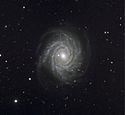NGC 1288
| Galaxie NGC 1288 | |
|---|---|
 | |
| Aufnahme mittels des Very Large Telescope | |
| AladinLite | |
| Sternbild | Chemischer Ofen |
| Position Äquinoktium: J2000.0, Epoche: J2000.0 | |
| Rektaszension | 03h 17m 13,2s[1] |
| Deklination | −32° 34′ 33″[1] |
| Erscheinungsbild | |
| Morphologischer Typ | SA(rs)bc[1] |
| Helligkeit (visuell) | 12,1 mag[2] |
| Helligkeit (B-Band) | 12,8 mag[2] |
| Winkelausdehnung | 2,3′ × 1,9′[2] |
| Positionswinkel | 166°[2] |
| Flächenhelligkeit | 13,6 mag/arcmin²[2] |
| Physikalische Daten | |
| Rotverschiebung | 0,015137 ± 0,000013[1] |
| Radialgeschwindigkeit | (4538 ± 4) km/s[1] |
| Hubbledistanz H0 = 73 km/(s • Mpc) | (198 ± 14) · 106 Lj (60,7 ± 4,3) Mpc [1] |
| Durchmesser | 135.000 Lj[3] |
| Geschichte | |
| Entdeckung | John Herschel |
| Entdeckungsdatum | 19. November 1835 |
| Katalogbezeichnungen | |
| NGC 1288 • PGC 12204 • ESO 357-013 • MCG -05-08-025 • IRAS 03152-3245 • 2MASX J03171317-3234330 • SGC 031512-3245.5 • HIPASS J0317-32 | |
NGC 1288 ist eine Spiralgalaxie vom Hubble-Typ Sbc im Sternbild Fornax am Südsternhimmel. Sie ist schätzungsweise 198 Millionen Lichtjahre von der Milchstraße entfernt und hat einen Durchmesser von etwa 135.000 Lj.
Im selben Himmelsareal befindet sich u. a. die Galaxie IC 1913.
Am 17. Juli 2006 entdeckte der Amateurastronom Berto Monrad mit seinem 30-Zentimeter-Teleskop die Typ-Ia-Supernova SN 2006dr.[4]
Das Objekt wurde am 19. November 1835 von dem Astronomen John Herschel entdeckt.[5]
Weblinks
- SIMBAD Astronomical Database
- CDS Portal
- astronews: Bild des Tages 8. November 2012
- astronews: Eine Supernova in NGC 1288 3. September 2007
Einzelnachweise
Auf dieser Seite verwendete Medien
Autor/Urheber: ESO, Lizenz: CC BY 4.0
Colour-composite image of the Type Ia supernova SN 2006dr in the spiral galaxy NGC 1288, as observed with ESO's Very Large Telescope. It is based on images acquired through several filters (B, V, R, I and H-alpha) for a total exposure time of 5 minutes. The supernova is the bright object visible to the left of the centre of the galaxy. Many distant galaxies are also seen in the vicinity of NGC 1288, of which some are behind.
